Professor Neely and the Death Ray of Doom
| Developer: | Nathaniel Oliveira | 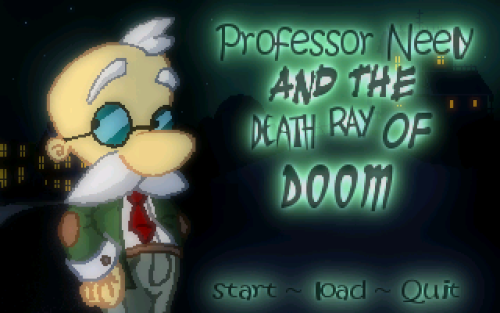 The title screen. The title screen. |
| Released: | 2010.12.14 | |
| Genre: | SciFi / Comedy | |
| Graphics: | Pixel art / 2D | |
| Perspective: | Third person | |
| Gameplay: | Point-and-Click |
| Note: this game can be played with ScummVM software. |
Professor Neely is a retired college professor who has invented Z-22 vacuum tube, which is an important thing for some reason. One day he receives a fake invitation to lure him into a house where somebody from his past is not only trying to steal his invention, but also get his revenge. Professor Neely is obviously the protagonist in the game, the evil inventor the antagonist, and a third person to appear in the game is Egore, a usual disfigured kind of servant for the madman antagonist who is more than ready to switch sides with very little persuation. The house where these three characters come together is where the game begins, and it is also where it stays and ends. To reference another game, which obviously has been a spiritual inspiration for this one, there is an undeniable Maniac Mansion feeling, with just a little bit less "maniac" and a little bit less "mansion".
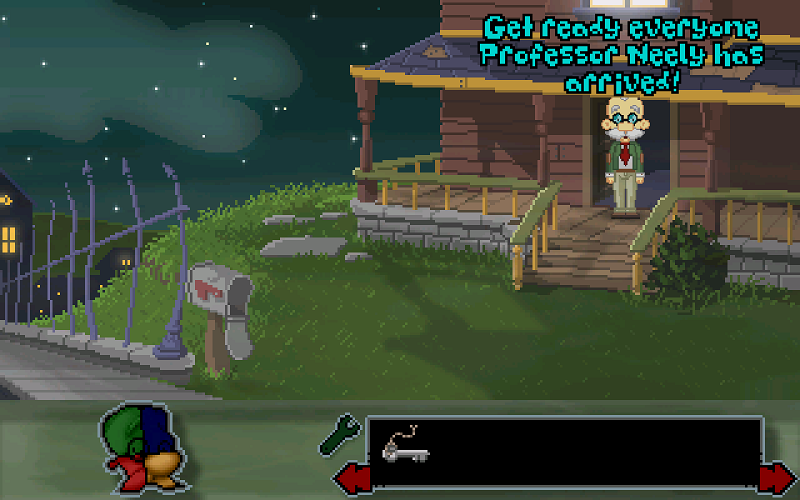 Professor Neely and the "Maniac Mansion".
Professor Neely and the "Maniac Mansion".
Professor Neely, the game, can be best described as a short cartoony comedy game with a plot that combines some science fiction elements, such as dangerous inventions and mad inventors, and which gameplay-wise is a series of escape room situations. The latter expression not to be taken too literally here, as most of the puzzles in the game are actually about breaking in, not breaking out. And from the very first moment this pattern gets repeated, as Professor Neely first needs to break into the house (which is a bit illogical, isn't it, as he was invited there to walk into a trap??), and then find a way to open doors in the house, which mostly are locked, of course. AdventureDoors are like that.
While the gameplay certainly could use a little bit more variation, as locked doors get a bit boring after a while both in this game and in the genre generally speaking, there is a good effort to allow some free thinking in the game. There are a couple of puzzles which have alternative solutions. The outcome is more or less the same, nothing affects the narrative, but it is always refreshing to see some attempt to allow different thought processes for same puzzles. Finding such a thing in a short freeware game is definitely a pleasant surprise.
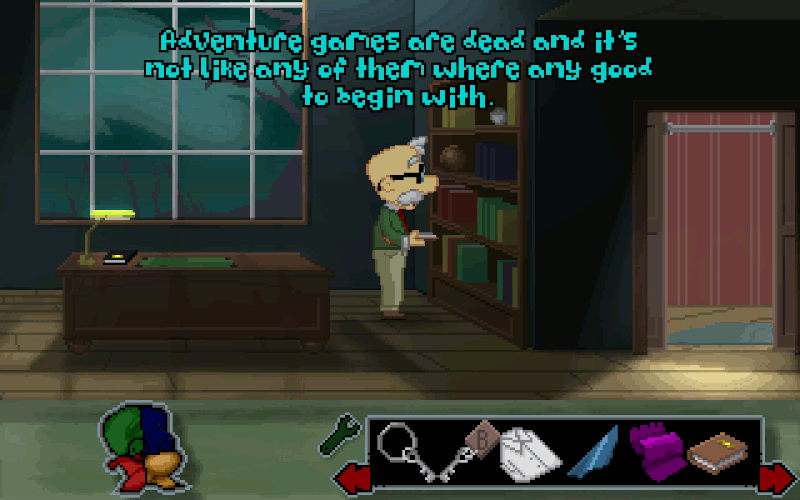 The truth about adventure games.
The truth about adventure games.
The game looks and feels nice throughout. Cartoony graphics look nice and are really connecting to the old LucasArts and Sierra classics, which has been the intention here by the creator's own description. Animations are a bit clunky here and there, but ultimately, who cares? No one expects to find the best ever animation in a game of this scope, and whatever exists in the game is good enough to keep it going. There isn't much to comment about sounds in the game other than sound effects do their job when needed. There are no voiceovers for any characters, but there is an interesting and potentially annoying speech sound effect that can be turned on and off in the game options. Fortunately so, as not everyone is going to like it and hearing such a sound in place of dialogues can be annoying after a while.
The worst thing about the game is that many of the items in the inventory are mislabelled, or misspelled, how ever one wants to call it. For instance, picking up mail from the mailbox appears in the inventory as "maill" and picking up nails (as in things to be used with a hammer) creates an inventory item "nales" and so on. After a while one begins to wonder whether this is intentional, a form of joke or some kind of secret puzzle. Turns out it is neither, as far as anyone is able to tell, and it's just a matter of typos. Having so many of them immediately raises the question: if that is what's happening on the screen, just how bad is the code lying underneath? Whatever code hacks have been used, the game seems to be very stable and run without bugs. Not counting several intentional bug creatures in the bug puzzle. So the problems appear to be in the proof-reading only, which makes it slightly annoying, but a non-critical issue.
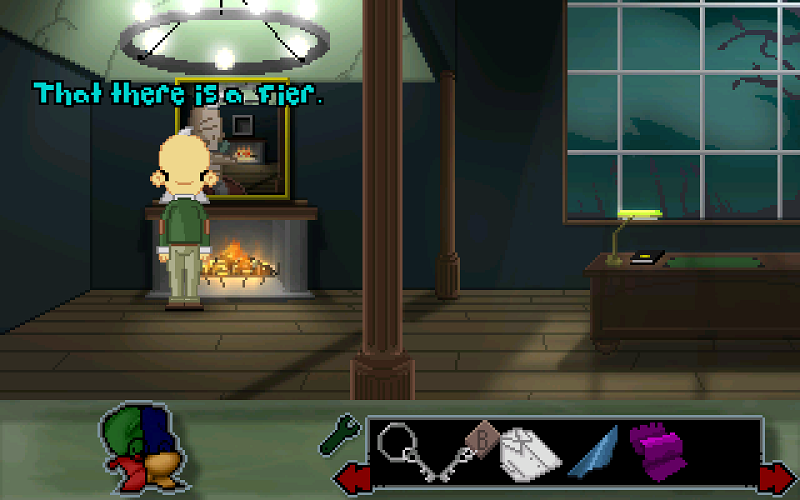 A fier in a fierplace.
A fier in a fierplace.
Another minor complaint goes to the user interface. While everything is pointy and clicky with four different action verbs, the way to differentiate these is by colours only. That's right. The cursor remains the same, and is green for looking, blue for taking, red for talking, and yellow for using things. There is a head with these four colours on it that can be used to select and explain the colours, but they don't correspond in any kind of way to the actions. For instance, eyes don't have the colour for looking, as one eye is on the green side and another one is on the blue side. This makes the game a lot less user-friendly as it could otherwise be. While with only four verbs this isn't such a big issue, simply having different cursor shapes for different actions would have been a better choice.
The game flows nicely until the very end, when the puzzles which are mostly logical to solve become a bit random, and the narrative gets abruptly cut without any major conclusion or confrontation between the good and evil scientists. For puzzles with only one solution, there could be sometimes more clues on how to solve them. Especially when the inventory items that weren't used in the puzzles with alternative solutions remain in the inventory as red herrings of sorts.
Despite some things which could have been better in the game, it has one important noteworthy thing in it: it is a joy to play. While the locked room scenario is too repetitive, and the game has some weaknesses as described above, it is charming enough that playing doesn't become too boring at any point. The puzzles are challenging enough that they aren't obvious from the first look, but can mostly be reasoned without resorting to random trial and error methods. For what the game tries to be, a throwback to the 90s style of point and click formula, it works in an excellent fashion.
By the time the end credits flash on the screen, there's this thought emerging that the game could have been longer, or that it needs a sequel. That is always a very good sign. The game has a perfect length for the small scope that it has. Making a bigger game would also need a bigger narrative. Anyone appreciating the old golden 90s formula with some nice pixel arts is going to have some nice moments with Professor Neely and the Death Ray of Doom. It won't become a classic title by its own merits, but it should always be respected when someone is trying to create an original title, rather than creating a fan game (not that fan game concept is a negative thing as such). Professor Neely is one of those games that not too many people know about, but that are absolutely a pleasure to play. There should be more games like that.
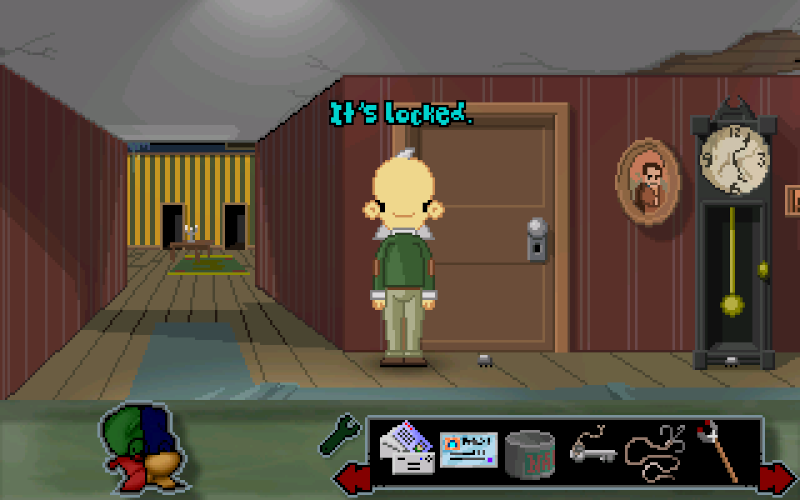 The door is locked.
The door is locked.
